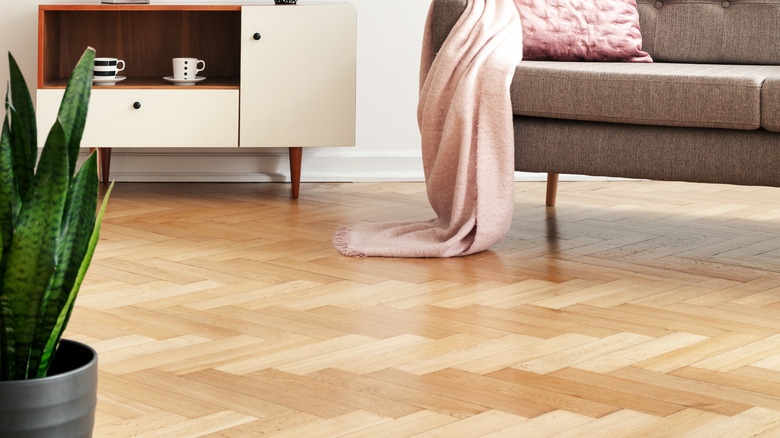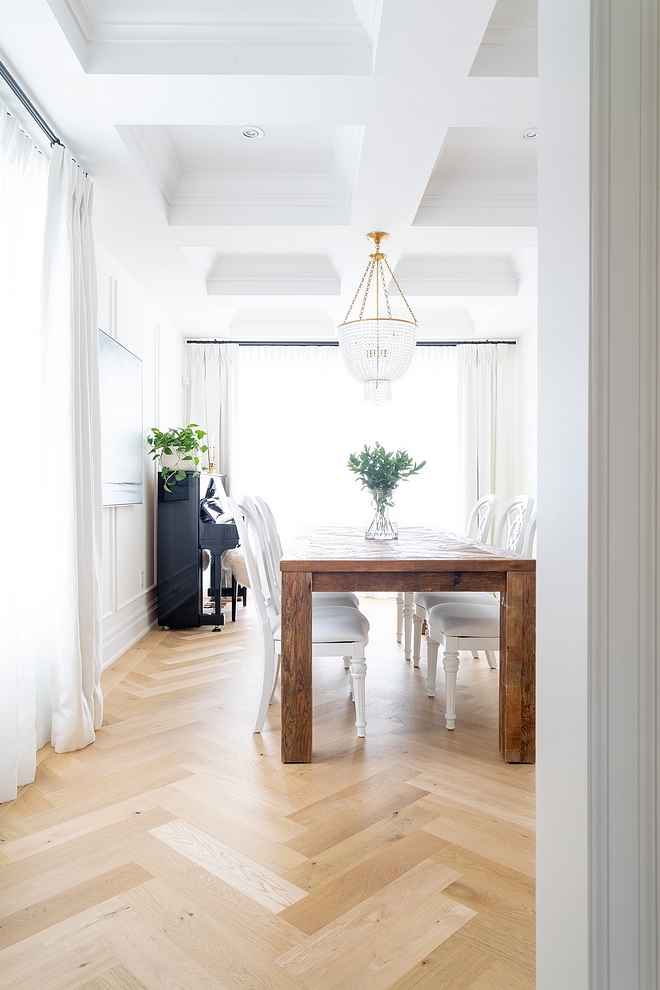Have you ever walked into a room and immediately felt overwhelmed by the design or thought it looked smaller than it actually was? One common culprit, often overlooked, is the flooring choice. While herringbone flooring has surged in popularity for its timeless elegance and unique visual appeal, many wonder if it might shrink the space. This blog post will delve into the fascinating world of herringbone flooring, exploring its potential impact on room size and uncovering the secrets to choosing the right design for your space.

Image: www.housedigest.com
My own journey with herringbone flooring began a few years ago when I renovated my living room. I initially fell in love with the sophisticated look of herringbone patterns, visualizing them in my space. However, my friend, an interior designer, cautioned me about using them in my modest living room, suggesting that it would make the space look smaller. I was skeptical at first but decided to proceed cautiously, opting for a smaller-scale herringbone pattern and incorporating large mirrors to counterbalance the visual effect. To my surprise, the final outcome was stunning; the herringbone pattern added a touch of elegance without diminishing the room’s size. This experience sparked my curiosity to understand the design principles behind herringbone flooring and how it truly affects the perception of a space.
Delving into the World of Herringbone Flooring
Herringbone flooring, with its distinctive “V” shaped pattern, has a rich history, dating back to Roman times. It was initially used for practicality, offering durability and resistance to wear and tear. Today, it’s a popular choice for both modern and traditional homes, adding an intricate visual element to any space. While the herringbone pattern is undeniably eye-catching, the debate continues: does this distinctive arrangement truly make a room look smaller?
The answer, however, is not as straightforward as a simple “yes” or “no.” Whether herringbone flooring visually shrinks a room depends on several factors, including the size of the room, the scale of the herringbone pattern, and the color choice. It’s a question of visual perception, and the way our brains interpret lines and patterns. A smaller-scale herringbone pattern, with narrow planks, generally blends seamlessly into the background, while larger-scale patterns, with wider planks, can create a more pronounced, even bold, visual effect within a room.
How Herringbone Flooring Affects Room Size: Deeper Insights
The Illusion of Space: How Lines and Patterns Shape Our Perception
Herringbone patterns, with their diagonal lines, are known to create a dynamic visual effect. They inherently draw the eye across the room, generating a sense of movement and depth. This can be beneficial in creating a more interesting, less static visual experience. However, this visual movement can also lead to the perception of a smaller room, particularly if the herringbone pattern is too large or the colors are dark.

Image: www.homebunch.com
The Impact of Size and Scale
Smaller-scale herringbone patterns, featuring narrow planks, tend to be more subtle, blending seamlessly into the overall design of the room. This makes them particularly well-suited for smaller spaces where visual clutter is a concern. Large-scale herringbone patterns, with wider planks, create a more pronounced visual impact, adding a distinct personality to the room. However, in smaller rooms, it can also create a sense of overwhelming visual intensity, making the space feel even more compact.
The Role of Color and Lighting: Lightening the Mood
The color and shade of herringbone flooring can significantly influence the perceived size of a room. Lighter shades of wood, such as blonde oak or maple, reflect light, creating a sense of spaciousness. Darker shades, conversely, absorb light, making the space appear smaller. Similarly, proper lighting is crucial, as it can amplify the effect of color. Well-lit rooms, with natural or artificial light, can brighten the space, making it appear larger.
Balancing the Look: Expert Advice and Tips
To counteract the potential for herringbone flooring to make a room appear smaller, consider incorporating a few strategies into your design plan. These strategies will not only mitigate any shrinking effect but also enhance the overall visual appeal of your space.
Maximizing Space: Expert Tips for Using Herringbone Flooring
1. Choose a smaller-scale herringbone pattern. Narrower planks will create a more subtle visual effect, minimizing the impact on the room’s perceived size.
-
Opt for lighter wood shades. Lighter colors help to reflect light and create a sense of spaciousness.
-
Incorporate mirrors. Strategic placement of mirrors can reflect light and create the illusion of a bigger room.
-
Use contrasting rugs. A contrasting rug can define a space and add visual interest, while minimizing the visual impact of the herringbone flooring.
-
Integrate plenty of natural lighting. Maximize natural light sources by using large windows and light-colored curtains or blinds.
-
Ensure proper artificial lighting. A combination of overhead and task lighting will illuminate the space, minimizing the potential for a “shrinking” effect.
-
Choose minimal furniture pieces with lighter colors and simple designs to avoid overcrowding the space.
FAQ: Herringbone Flooring and Room Size
Q: Can I use herringbone flooring in small rooms?
A: Yes, you can, but be mindful of the scale and color choices. Opt for a smaller-scale pattern and lighter wood shades. Consider incorporating mirrors and light-colored furniture to maximize the perceived space.
Q: Does herringbone flooring make a room feel cramped?
A: It can if the pattern is too large or the colors are too dark. To avoid this, consider a smaller-scale pattern and lighter wood shades.
Q: How can I make my herringbone flooring look less overwhelming in a small space?
A: Incorporate mirrors, use light-colored furniture, maximize natural light, and choose a smaller-scale pattern with lighter wood shades.
Q: What are the best ways to create a visually appealing room with herringbone flooring?
A: Choose a scale that complements the room size, pick colors that enhance the overall ambiance, and consider the balance of furniture placement and light.
Does Herringbone Flooring Make A Room Look Smaller
Conclusion: The Verdict on Herringbone Flooring and Room Size
While herringbone flooring can indeed make a room look smaller, it doesn’t have to be a design no-no. By carefully considering the scale of the pattern, choosing the right color and incorporating light strategically, you can create a stylish and visually appealing space that maximizes the perceived size of your room. Remember, it’s all about striking the right balance between elegance and functionality.
Are you excited to explore the possibilities of herringbone flooring in your own home? Share your thoughts in the comments below, and let’s discuss your own design aspirations!





